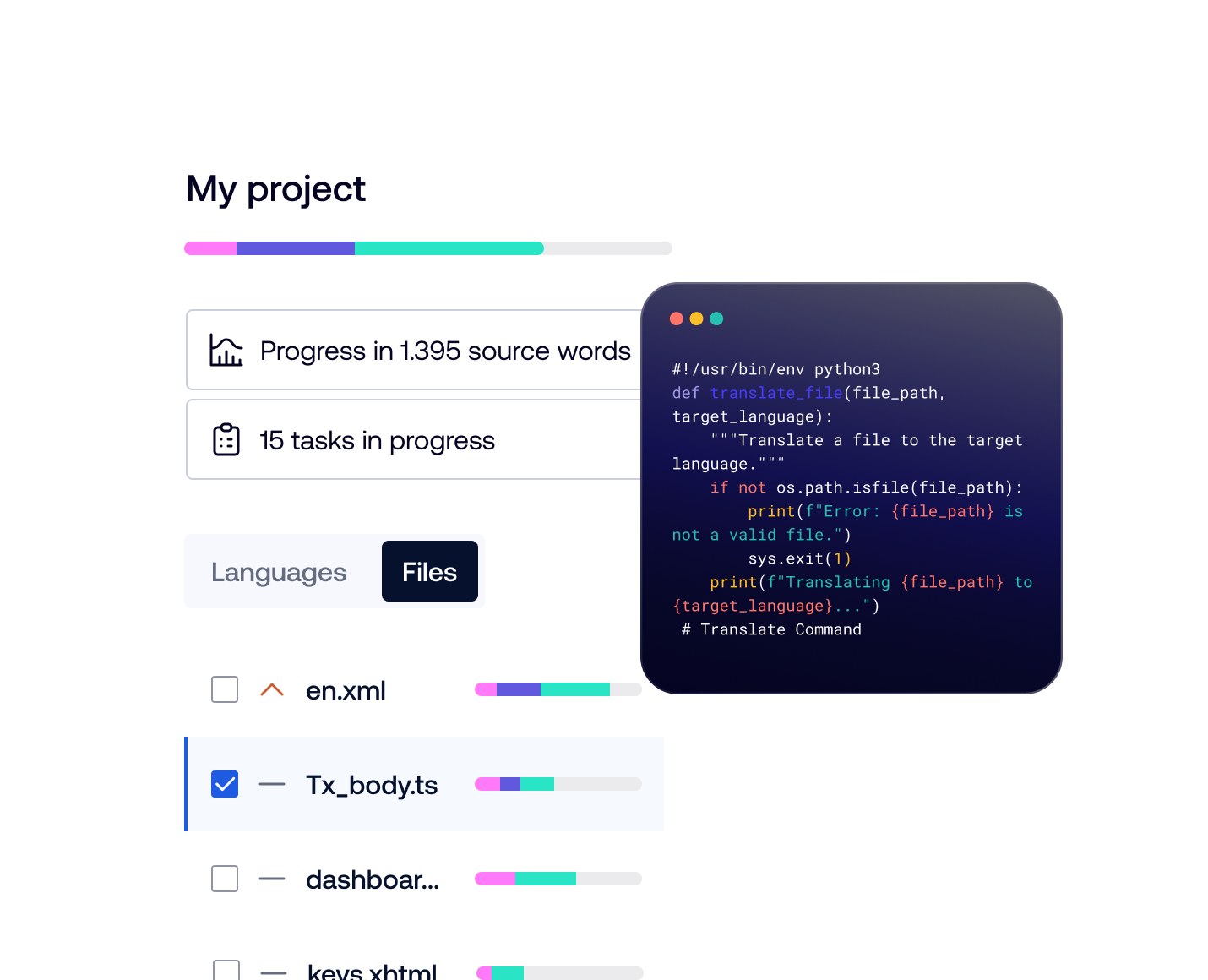Why Transifex is the Software Localization Tool of Choice for Tech Teams
Development teams need a software localization tool that keeps pace with rapid release cycles. Whether you're managing mobile apps, web applications, or software products across different languages, our cloud-based platform integrates localization directly into your existing development workflow.
-
Continuous localization
-
Speed and quality
-
Collaboration Hub
-
Smarter Translation Management
-
Automated Localization Workflows
Continuous Localization for CI/CD Workflows
Make software localization part of your continuous integration pipeline. Our software localization tool automatically syncs with code repositories like GitHub, GitLab, Azure Repos, and Bitbucket. When your development team pushes product updates, translations happen automatically—ensuring your target market receives updates in their native language without slowing down your development cycle.

Accelerate Workflows with AI Translations & Translation Memory
Speed matters, but translation quality can't be compromised. Transifex Language AI and Quality Index (TQI) deliver accurate translations that maintain your brand's tone of voice. Automated quality assurance runs in the background, freeing your QA team to focus on core features.

Collaborate and Manage Software Localization in Real Time
Localization isn’t just a developer’s job, it’s a team effort. With our software localization tool you can bring everyone together, from developers to product or project managers, and translators. Collaborate efficiently with in-app comments and screenshots, stay aligned with Jira and Slack integrations and organize your projects effortlessly using custom tags.

Automate Translation Management For your Localization Projects
Automate translations with CLI commands to sync files, SDKs for real-time updates, and a flexible API to customize workflows or dynamically fetch translations. Let your localization process run on autopilot, freeing up your team’s time while keeping development cycles on track.

Complete Localization Projects with Minimal Setup
Sync your GitHub repo with our software localization platform and let every newly pushed update be localized instantly. Automatically publish production-ready translations without human intervention, turning any team member into a localization expert, even with no language expertise.

Proven Results from Leading Software Companies
Celonis
Real- time updates to deliver multilingual content with no deployment delays
HubSpot
Automate repetitive tasks like string updates, saving hours of work each sprint
Deezer
From React and Angular to Android and iOS, Transifex integrates seamlessly into your development stack
A Suite of Software Localization Tools
AI-Powered End-to-End Software Localization
Xera is the only AI software localization tool designed to enable one person to manage an entire release in a single session, even without knowledge of the target language.
- AI orchestrates the entire workflow, from string extraction to translation, QA, and publishing.
- Handle high-volume content with intelligent language processing for apps, websites, and tech files
- Translation Quality Index (TQI) offers actionable feedback with context, enabling users to fix issues even without language expertise
- Over-the-air (OTA) updates keep translations in sync with your product development.

Centralized Translation Management System
Keep large teams, LSPs, and external linguists aligned with streamlined workflows and powerful tools designed for seamless collaboration.
- Enable better teamwork with comments, screenshots, tags, and custom statuses
- Access to advanced AI-tools like Language AI and TQI
- Integrate with CI/CD pipelines to automate updates and enable real-time localization
- Translation Memory, Glossary, CAT and many more in-context tools
- Project: Live and Project: Native for complete control over web and software projects

On-Brand AI Translations at Scale
Deliver fast, accurate ai translations that maintain your brand voice and context across different languages and locales.
- Context-aware high-quality translations with built-in qa checks
- Automated post-editing with the Translation Quality Index (TQI)
- Integrated with Transifex TMS and Xera workflows
- Seamless integration with existing tools via API

How Transifex Fits Into Your Team’s Software Localization Workflow
-
For Product Teams
-
For Developers
-
For Localization Teams
-
For Marketing Teams
Advanced translation tools and project management automations
- Localize into different languages while staying on budget with AI automation
- Integrate localization into your product roadmap for on-schedule releases and improved ROI across all markets
- Centralized localization management, ensures visibility across projects and teams

Stop treating localization as an afterthought. Use our software localization tools
- Automate translations directly from your codebase with SDKs for React, Vue, iOS, and more
- Integrate with CI/CD tools to localize continuously as you push updates
- Handle entire localization projects with just a few clicks and no language expertise with our fully automated AI translation platform

Advanced translation tools and localization management
- Translation memory and terminology management maintain consistency across all projects and target markets
- Advanced quality assurance tools with contextual reviews streamline the localization process for professional translators
- Enterprise-grade localization features for automated quality control and workflow efficiency

Ensure brand consistency across global campaigns
- Maintain your brand's tone of voice and across all target markets and regions
- Marketing workflow integration with approval processes enables seamless collaboration between marketing teams and translators
- Real time preview and editing capabilities allow marketing managers to review localized content before publication


Senior Manager
Localization & Systems at HubSpot
Faster localization workflows
With Transifex, we’ve been able to significantly reduce turnaround times for translations, enabling us to launch new features and products across all languages at the same time.

Julia
Senior Training Manager, Celonis
Less time spent on translations
Transifex has cut our time-to-market in half and accelerated our translation processes. It truly feels like we are one team, working together towards a common goal.

Yichi Chen
Product Manager, EventMobi
Faster content roll-out
I 100% recommend that any product or engineering leaders involved in localization find an expert like Transifex to handle it with automations to save time and focus on essential tasks.


Software Localization FAQs
Still got questions? Talk with the Transifex Team to see how you can improve the quality of your translations and save money.
What is a software localization tool?
What is an example of software localization?
What is software localization in open source technology?
What are the 2 types of localization?
How do you localize a program?
What are the challenges of software localization?
Why is software localization important?
How is localization done?
What is the difference between internationalization and localization?
How to start localization?
Learn more about software localization
Software localization is more than the translation of your product UI. Different language settings, plural forms, frameworks used and visual relevancy factors are only a few other things to consider.












